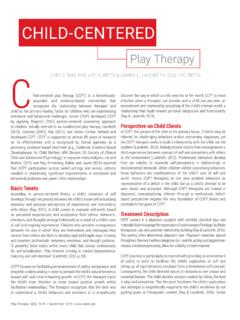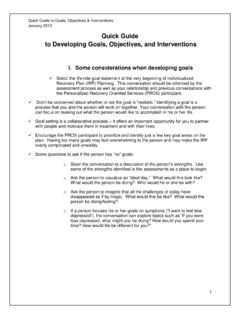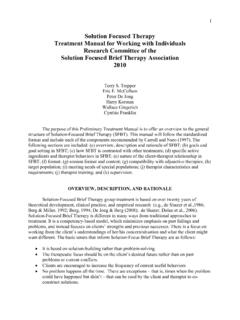Transcription of Chapter 6 Treatment of Tuberculosis Disease
1 Chapter 6: Treatment of Tuberculosis Disease139 Table of ContentsChapter Objectives .. 139 Introduction .. 141 Treatment and Monitoring Plan .. 143 Adherence Strategies .. 143TB Disease Treatment Regimens .. 151TB Disease Treatment Regimens for Specific Situations .. 165 Patient Monitoring .. 176 Evaluating Response to Treatment .. 178 Chapter Summary .. 186 References .. 187 Chapter ObjectivesAfter working through this Chapter , you should be able to Describe Tuberculosis (TB) Disease Treatment adherence strategies; Identify anti-TB drugs; Describe Treatment regimens for TB Disease ; Describe patient monitoring; and List common adverse drug reactions to TB 6 Treatment of Tuberculosis DiseaseChapter 6: Treatment of Tuberculosis Disease141 IntroductionThe major goals of Treatment for TB Disease are to Cure the individual patient; Minimize risk of death and disability; and Reduce transmission of M.
2 Tuberculosis to other persons . To ensure that these goals are met, TB Disease must be treated for at least 6 months and in some cases even longer. Most of the bacteria are killed during the first 8 weeks of Treatment ; however, there are persistent organisms that require longer Treatment . If Treatment is not continued for a long enough duration, the surviving bacteria may cause the patient to become ill and infectious again, potentially with drug-resistant are several options for daily and intermittent therapy , but the goal of Treatment for TB Disease should be to provide the safest and most effective therapy in the shortest period of time. Given adequate Treatment , almost all patients will recover and be cured. Regimens for the Treatment of TB Disease must contain multiple drugs to which the bacteria are susceptible. The standard of care for initiating Treatment of TB Disease is four-drug therapy .
3 Treatment with a single drug can lead to the development of a bacterial population resistant to that drug. Likewise, the addition of a single drug to a failing anti-TB regimen can lead to additional resistance. When two or more drugs to which in vitro susceptibility has been demonstrated are given together, each helps prevent the emergence of tubercle bacilli resistant to the standard of care for initiating Treatment of TB Disease is four-drug therapy . Treatment with a single drug can lead to the development of a bacterial population resistant to that The major goals for Treatment of TB Disease include which of the following?A. Curing the individual patientB. Minimizing risk of death and disabilityC. Reducing transmission of M. Tuberculosis to other personsD. A, B, and C are all Only A and B are 6: Treatment of Tuberculosis Disease142 Are the following statements about TB Treatment true or false?
4 (Choose the one best answer and write the letter for the correct answer on the line next to the question number.)Statements True or False____ Most of the TB bacteria are killed during the first 8 weeks of Treatment . However, some persistent organisms require longer Regimens for the Treatment of TB Disease need to only contain one drug to which the bacteria are Treatment that is not continued for a long enough time allows the surviving bacteria to cause the patient to become ill and infectious Treatment with a single drug cannot lead to the development of a bacterial population resistant to that When two or more drugs to which in vitro susceptibility has been demonstrated are given together, each helps prevent the emergence of tubercle bacilli resistant to the other drugs(s).____ Given adequate Treatment , almost all patients will recover and be Tr u eB.
5 FalseChapter 6: Treatment of Tuberculosis Disease143 Treatment and Monitoring PlanFor each patient with newly diagnosed TB Disease , a specific Treatment and monitoring plan should be developed in collaboration with the local TB control program within 1 week of the presumptive diagnosis. This plan should include: Description of the TB Treatment regimen; Methods of assessing and ensuring adherence to the TB Treatment regimen; Methods to monitor for adverse reactions; and Methods for evaluating Treatment Which of the following should NOT be included in a Treatment and monitoring plan? (choose the one best answer)A. Description of the TB Treatment regimenB. Methods of assessing and ensuring adherence to the TB Treatment regimenC. Methods to monitor for adverse reactionsD. Methods to prevent a patient returning to work when noninfectiousE. Methods for evaluating Treatment responseAdherence StrategiesTo treat TB Disease and prevent acquired drug resistance, clinicians must ensure that their patients with TB Disease follow the recommended course of Treatment .
6 However, ensuring that patients adhere to Treatment can be difficult because patients are often unable or reluctant to take multiple medications for several months. Nonadherence to Treatment is a major problem in TB control. Inadequate Treatment can lead to Treatment failure; Relapse; Ongoing transmission; and Development of drug resistance. Responsibility for successful Treatment is assigned to the health-care provider, not the patient. Health-care professionals should consult their health department s TB control program to ensure their TB patients are able to adhere to a prescribed Treatment regimen. The TB control program should assist the health-care professional in evaluating patient barriers to adherence and recommend directly observed therapy (DOT) and the use of incentives and enablers that may assist the patient in completing the recommended therapy . Chapter 6: Treatment of Tuberculosis Disease144 Inadequate Treatment can lead to Treatment failure, relapse, ongoing transmission, and the development of drug for successful Treatment is assigned to the health-care provider, not the these efforts are unsuccessful, the TB control program should take more restrictive action.
7 The TB program should consider court-ordered DOT or, if all other measures fail, the involuntary isolation of a patient who is unwilling or unable to complete Treatment . This is necessary to protect the general public from patients who are infectious, at risk of becoming infectious, or at risk for developing drug-resistant TB Disease . A patient may be involuntarily isolated, but the patient cannot be forced to swallow anti-TB drugs. Involuntary isolation should only be pursued as a last resort after all less-restrictive measures have EducationEducating patients about TB Disease helps ensure their successful completion of therapy . Health-care providers must take the time to explain clearly to patients what medication should be taken, how much, how often, and when. Patients should be clearly informed about possible adverse reactions to the medications they are taking and when to seek necessary medical attention.
8 Providing patients with the knowledge they need regarding the consequences of not taking their medicine correctly is very important. In addition, patients should be educated about infection control measures and potential need for isolation (Table ). HIV testing and counseling is recommended for all patients with TB Disease in all health-care settings. The patient must first be notified that testing will be performed. The patient has the right to decline HIV testing and counseling (opt-out screening). Table Patient EducationTopics to Include When Educating Patients What medication should be taken, how much, how often, and when Possible adverse reactions to the medications When to seek necessary medical attention Consequences of not taking their medicine correctly TB infection control measures and potential need for isolationHIV testing and counseling is recommended for all patients with TB Disease in all health-care 6: Treatment of Tuberculosis Disease145 Case ManagementCase management is a strategy used to ensure that patients complete Treatment for TB Disease .
9 There are three elements of case management: 1. Assigning responsibility;2. Conducting a regular systematic review; and3. Developing a plan to address barriers to managers are health department employees, usually nurses or public health professionals, who are assigned primary responsibility for the management of specific patients. Case managers are held accountable for ensuring that each patient is educated about TB and Treatment , ensuring that therapy is continuous and complete, and confirming that all contacts are evaluated according to CDC/National Tuberculosis Controllers Association guidelines. Some specific responsibilities may be assigned to other persons such as clinic supervisors, outreach workers, health educators, social workers, and human service workers. Case management is a patient- centered strategy. Whenever possible, a worker who has the same cultural and linguistic background as the patient should be assigned as case manager, to be able to help develop an individualized Treatment adherence plan with the patient.
10 Case managers are held accountable for ensuring that each patient is educated about TB and Treatment , ensuring that therapy is continuous and complete, and confirming that all contacts are evaluated according to CDC/ National Tuberculosis Controllers Association Observed therapy (DOT)DOT is a component of case management that helps ensure patients adhere to therapy . It is the method whereby a trained health-care worker or another trained designated person watches a patient swallow each dose of anti-TB drugs and documents it. DOT is the preferred core management strategy recommended by CDC for Treatment of TB Disease and, if resources allow, for latent Tuberculosis infection (LTBI) Treatment . DOT can reduce the development of drug resistance, Treatment failure, or relapse after the end of Treatment . Good case management, which includes establishing a relationship with the patient and addressing barriers to adherence, facilitates successful is the preferred core management strategy recommended by CDC for Treatment of TB Disease and, if resources allow, for latent Tuberculosis infection (LTBI) all the Treatment regimens for drug-susceptible TB Disease can be given intermittently if they are directly observed.


















